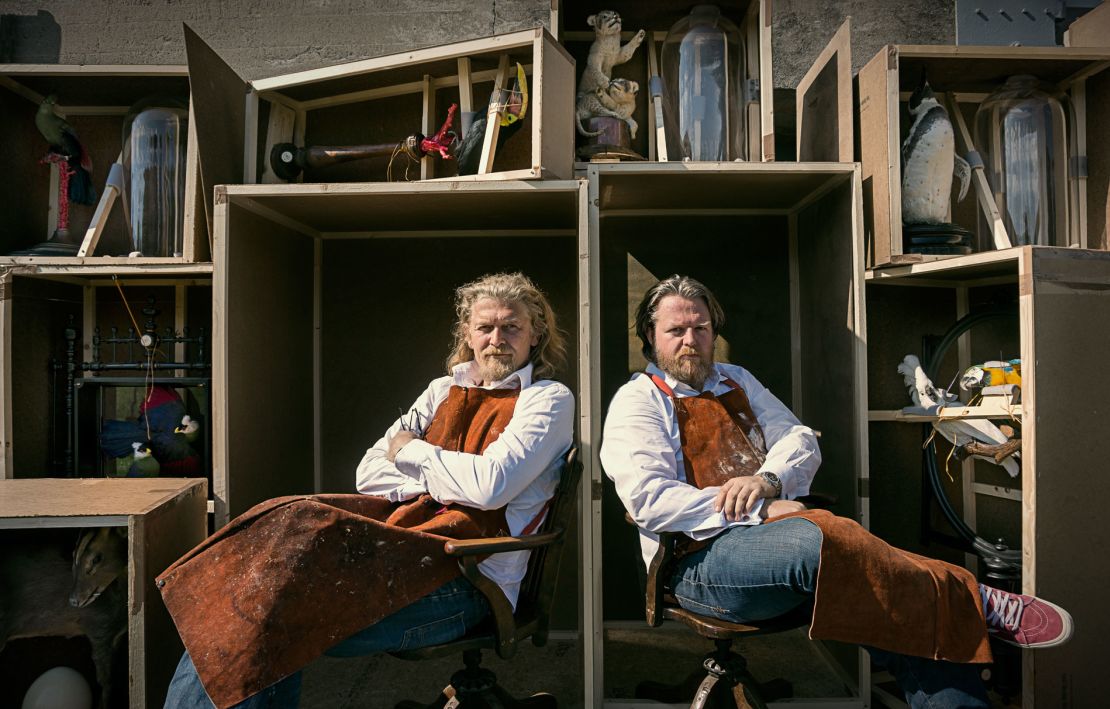Story highlights
Two Dutch artists are revolutionizing the world of taxidermy
They have returned to Victorian techniques, producing works of exceptional quality
It's not about death, it's about beauty, they say
Ferry van Tongeren believes that there are two types of people in the world: those who like dead animals, and those who don’t.
Being a professional fine-art taxidermist, it’s obvious what category he places himself.
“I know it’s hard to believe, but the presence of death has nothing to do with it for me,” says the Dutch artist.
“It’s about shapes, color and construction, not death. But if you think it’s gross, I can’t even start to explain the beauty to you.”
Then, after a moment of reflection, he adds: “I’m not weird.”
As part of the Darwin-Sinke-van-Tongeren collective – which makes the unusual move of including Charles Darwin as a member – van Tongeren and his artistic partner, Jaap Sinke, create extraordinary taxidermy artworks that have been and acclaimed all over the world.

The pieces are inspired by the paintings of 17th Century painters like Jan Weenix, Melchior d’Hondecoeter and Adriaen van Olen, and have been called “flamboyant 17th century luxury”
The blend of retro-cool and exquisite workmanship led one reviewer to say that it “elevates taxidermy to a higher plane”.
There is no doubt: van Tongeren and Sinke – who sport wild hair and beards and wear matching leather aprons – are the hottest thing to happen to taxidermy in decades.
Demand is growing for their work, with pieces selling for between £2,000 and £25,000. n 25 November, their latest exhibition will be coming to the Shapero Rare Book store in London.
Late starter
Given these achievements, many find it hard to believe that van Tongeren has only been in the game for three years.
“I was 47 years old, and was running my own advertising agency,” he recalls.
“We were on a family holiday in New Zealand, and over dinner I just said to my wife, ‘I know what I want to do. I want to be a taxidermist’.
“It had never occurred to me before that day, and it changed my life overnight.”
His wife “has accepted it”, and his two children, he says, “love it”.
His 15-year-old son helps with the stuffing, and his six-year-old daughter likes it too – though “she gets a bit worried when I start stroking the cat.” (Van Tongeren has a cat and a dog, which he has no intention of stuffing. For now.)
Part of the secret to the duo’s success is the quality that is evident from their work.
In some quarters taxidermy has become quite trendy over recent years, but it’s rare to find stuffed animals that can genuinely be mistaken for living creatures.
“We use the old-fashioned, Victorian methods,” he explains. “In those days, labor was not so expensive so they took their time over everything. But now mass production has taken over, so speed has taken over.
“Most modern taxidermists buy a ready-made mannequin and stretch the skin over the top.
“But we take months over each animal. We do it as it should be done, and the results speak for themselves. It takes months rather than hours.”
The beauty of death
Among the works of art van Tangeren and Sinke have produced are a beautiful flamingo with raised wings; a parrot with its feathers spread into an artistic action pose; a monkey with its tail raised in a flamboyant circle; and a red-billed, blue magpie, wings and tail stretched back as if in some magical flight.
“I love birds,” says van Tangeren. “We have a network of breeders and zoos who give us a call when a rare animal dies.
“As an artist, it’s a big advantage to start with something beautiful in itself. You can’t use paint to make colors like some birds have. The intensity of the colors and the layers of their feathers is breathtaking.”
In retrospect, van Tangeren’s sudden epiphany three years ago was not such a surprise. Since he was a child, he says, he was fascinated by dead animals, and has been collecting skulls all his life. (The centerpiece of his collection is the skull of a duck-billed platypus.)
“In a way, it’s about owning something beautiful,” he says. “As a child you don’t really own anything, but when you find a skull, you have a feeling that this is something worth a lot.
“That is the feeling that has stayed with me. I know it’s hard to believe, but it’s about capturing and holding beauty, not death.”
‘Avant gardens’: When art, design and a whole load of plants collide
Glamor and grieving: How the Victorians dressed for death
Intoxicating investment: How some whisky lovers are now making millions
This expressionist painted the world’s most radical nudes – 100 years ago
























